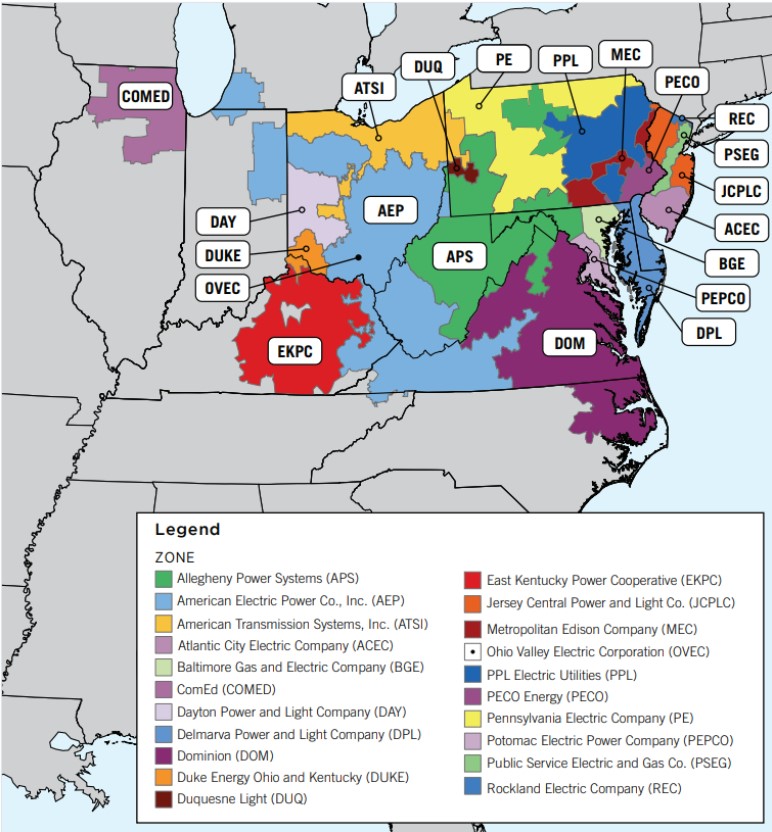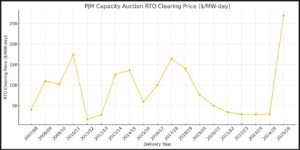PJM Capacity 2025

PJM Capacity Auction - update 2025 - 2026
The 2025/26 PJM Capacity Auction resulted in a historic surge in capacity prices, signaling significant implications for commercial electricity rates across the PJM Interconnection region, which includes 13 States.
Record-Breaking Price Increase
- Clearing Price Surge: The auction's clearing price escalated to $269.92 per megawatt-day, a substantial increase from the previous year's $28.92 per megawatt-day, marking an over 800% rise.
- Zonal Price Caps: Certain zones experienced even higher prices, with the Baltimore Gas and Electric (BGE) zone in Maryland reaching $466.35/MW-day and the Dominion zone in Virginia and North Carolina hitting $444.26/MW-day.
- Total Capacity Costs: The overall cost to consumers across the PJM region soared to $14.7 billion, up from $2.2 billion in the previous auction.

Impact on Commercial Electricity Rates
- Rate Increases: Commercial customers can anticipate double-digit percentage increases in electricity rates starting June 1, 2025, when the new capacity charges take effect.
- Geographical Variations: Businesses in areas with higher zonal prices, such as parts of Maryland and Virginia, may experience more significant rate hikes compared to other regions.
- Factors Influencing Rates: The extent of the impact on individual businesses will depend on factors like energy consumption patterns, existing contracts, and the specific utility providers in their area.
The PJM Interconnection (PJM) is a regional transmission organization (RTO) that coordinates the movement of wholesale electricity across 13 states and the District of Columbia.This area encompasses all or parts of the following states:
- Delaware
- Illinois
- Indiana
- Kentucky
- Maryland
- Michigan
- New Jersey
- North Carolina
- Ohio
- Pennsylvania
- Tennessee
- Virginia
- West Virginia
Contributing Factors to the Price Surge
Several elements contributed to the unprecedented increase in capacity prices:
- Generator Retirements: A notable number of power plant retirements reduced available capacity.
- Increased Demand: Rising electricity demand, partly due to the growth of data centers and electrification trends, tightened the supply-demand balance.
- Market Rule Changes: New rules, including updated resource accreditation metrics and considerations for extreme weather risks, affected capacity calculations.
- Transmission Constraints: Limited transmission capabilities in certain zones led to higher localized prices.
Looking Ahead
- Future Auctions: In response to the price surge, PJM has implemented a price cap of $325 per megawatt-day for the 2026/27 and 2027/28 delivery years to mitigate potential future spikes.
- Strategic Planning: Businesses are encouraged to review their energy procurement strategies, consider energy efficiency measures, and explore participation in demand response programs to manage and potentially reduce future electricity costs.
What Is the PJM Capacity Auction?
PJM Interconnection operates the electricity grid across 13 states and Washington, D.C., ensuring reliable power supply.To guarantee future electricity availability, PJM conducts annual capacity auctions under its Reliability Pricing Model (RPM).These auctions secure commitments from power generators and demand-response providers to supply or reduce electricity three years ahead, ensuring grid reliability during peak demand periods.
Participants bid to provide capacity and PJM selects the most cost-effective offers to meet projected demand plus a reserve margin.The resulting capacity prices are then incorporated into the electricity rates paid by consumers, including businesses like yours.
How It Affects Your Business Costs
Capacity charges are a component of your electricity bill, covering the cost of ensuring sufficient power supply.These charges are typically based on your peak electricity usage during specific high-demand periods identified by PJM.
Recent capacity auctions have seen significant price increases.For instance, the 2025/26 auction resulted in capacity prices soaring to $269.92 per megawatt-day, up from $28.92 the previous year—a nearly 833% increase . Such spikes can lead to substantial hikes in electricity bills for businesses, with some reports indicating potential increases of 29% or more starting in June 2025 .
Strategies to Lower Your Costs
To mitigate the impact of rising capacity charges, consider the following approaches:
1. Peak Load Management
Identify and reduce your electricity usage during PJM's peak demand hours, typically the hottest summer afternoons.By lowering consumption during these periods, you can decrease your capacity charges.
2. Demand Response Programs
Enroll in demand response initiatives where you agree to reduce or shift your electricity usage during peak times in exchange for financial incentives.This not only lowers your costs but also supports grid stability.
3. Energy Efficiency Improvements
Invest in energy-efficient equipment and practices to reduce overall electricity consumption.Lower usage translates to reduced exposure to high capacity charges.
4. On-Site Generation and Storage
Implement renewable energy solutions like solar panels or battery storage systems.These can supply power during peak periods, lessening reliance on the grid and associated capacity costs.
5. Consult Energy Experts
Work with energy consultants or service providers specializing in PJM markets.They can offer tailored strategies to optimize your energy usage and minimize costs.
Who is PJM Interconnection ?
PJM Interconnection is a Regional Transmission Organization (RTO) that coordinates the movement of wholesale electricity in all or parts of 13 states and Washington, D.C. It manages the high-voltage electric grid for more than 65 million people, making it the largest grid operator in North America.
Key Facts About PJM Interconnection:
- Founded: 1927 (as a power pool); became an RTO in 1997
- Headquarters: Valley Forge, Pennsylvania
- Coverage Area: All or parts of Delaware, Illinois, Indiana, Kentucky, Maryland, Michigan, New Jersey, North Carolina, Ohio, Pennsylvania, Tennessee, Virginia, West Virginia, and D.C.
- Primary Role: Ensure reliable grid operations and efficient electricity markets
What PJM Does:
- Grid Reliability:
PJM balances electricity supply and demand in real time, 24/7, to prevent blackouts - Wholesale Market Operator:
It runs competitive electricity markets, including:- Energy markets (buying/selling electricity)
- Capacity markets (like the PJM Capacity Auction)
- Ancillary services markets (e.g., reserves and frequency regulation)
- Transmission Planning:
PJM coordinates long-term planning for electric transmission infrastructure to ensure reliability and efficiency. - Market Oversight:
PJM ensures transparency, open access, and fairness in wholesale energy markets.
Why PJM Matters to Business Owners:
If your business is located in PJM territory, the organization indirectly affects your electricity costs through:
- Market-based pricing
- Capacity charges (determined by PJM auctions)
- Grid reliability and power quality
